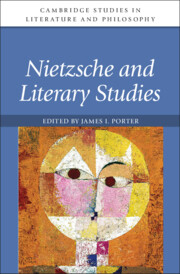Book contents
- Nietzsche and Literary Studies
- Cambridge Studies in Literature and Philosophy
- Nietzsche and Literary Studies
- Copyright page
- Contents
- Contributors
- Abbreviations
- Introduction
- 1 Heraclitus’ Clarity
- 2 Ariadne, or the Mediation of the Image
- 3 Nietzsche’s Centaurs
- 4 Nietzsche on the Task of the Poets in His Middle Writings
- 5 Some Images in Nietzsche’s Zarathustra
- 6 Nietzsche Ludens
- 7 Nietzsche and French Literature from the End of the Nineteenth Century to 1914
- 8 Ecce Mann
- 9 Plant Imaginaries and Human Existence in Nietzsche and Sartre
- 10 The Resources of the Figure
- 11 Nietzsche and Jewish Survival between Sarah Kofman and Jacques Derrida
- Editions and Translations of Nietzsche’s Works
- References
- Index
2 - Ariadne, or the Mediation of the Image
Nietzsche and Plato Revisited
Published online by Cambridge University Press: 03 May 2024
- Nietzsche and Literary Studies
- Cambridge Studies in Literature and Philosophy
- Nietzsche and Literary Studies
- Copyright page
- Contents
- Contributors
- Abbreviations
- Introduction
- 1 Heraclitus’ Clarity
- 2 Ariadne, or the Mediation of the Image
- 3 Nietzsche’s Centaurs
- 4 Nietzsche on the Task of the Poets in His Middle Writings
- 5 Some Images in Nietzsche’s Zarathustra
- 6 Nietzsche Ludens
- 7 Nietzsche and French Literature from the End of the Nineteenth Century to 1914
- 8 Ecce Mann
- 9 Plant Imaginaries and Human Existence in Nietzsche and Sartre
- 10 The Resources of the Figure
- 11 Nietzsche and Jewish Survival between Sarah Kofman and Jacques Derrida
- Editions and Translations of Nietzsche’s Works
- References
- Index
Summary
Although Nietzsche rejects the Platonic legacy in the name of the earth, there are resonances between the two thinkers. They share a critique of the Western democratic city. Both carry out a transvaluation of values: rejecting received notions of truth and justice. Both reject the notion that art, drama and tragedy occupy a separate “spectacular” sphere over against the quotidian life of the city. Both advocate a reintegration of life with art. Yet Nietzsche’s naturalism apparently allows only for the supremacy of the middle rank of Indo-European tripartition, to which Plato appeals in Republic: the Kshatriya power of aristocratic thumos. There is no place seemingly for the Brahmanic class of wise priestly rulers. How to understand the role of Zarathustra: is his advocacy of pure generosity an appeal to transcendence and so an irreducible good to which the warriors must advert? Inversely, is Plato’s good that which offers nothing in itself because it is beyond being, but only illuminates the terrestrial that comes after it and shares in it? Is it possible to mediate the two thinkers in this way? To a degree I shall argue that it is, though also that it is Plato whose metaphysical framework is less dualistic, who sees generosity less as merely accidental and as necessarily oscillating with cruelty.
- Type
- Chapter
- Information
- Nietzsche and Literary Studies , pp. 37 - 58Publisher: Cambridge University PressPrint publication year: 2024

